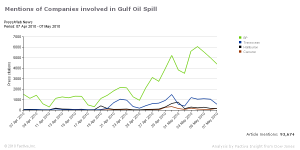The Buzz around Arctic Exploration
 Three main topics dominated coverage of the Arctic exploration in the second half of January: the deal between BP and Rosneft, Nordic pact and northern mini-NATO, and diminishing role of Canada in the region.
Three main topics dominated coverage of the Arctic exploration in the second half of January: the deal between BP and Rosneft, Nordic pact and northern mini-NATO, and diminishing role of Canada in the region.
The deal between BP and Rosneft caused an increase in media interest in Arctic exploration. The New York Times suggested that the Arctic exploration is likely to reinforce Russia’s dominance of the global natural gas industry and informed that THK-BP announced that the Russian private partners were not consulted about the Arctic exploration agreement. Analysts believe that support of the Russian state of the deal “should help reduce [BP’s] risk in Russia… but BP’s elaborate maneuvering could collapse at some point” (19/01).
The British Sunday newspapers closely followed the possibilities of oil production in Arctic. They covered the BP-Rosneft deal favourably despite the risks mentioned by BP executives. The Sunday Times quoted David Peattie, BP’s head of Russia as saying that “it is an experiment the rest of the industry will be watching with interest. If the region is as good as we think, this could be another North Sea” (16/01). Chris Weaver, chief strategist with UralSib Financial Corporation in Moscow, commented in his blog that the results of the exploration will be decisive for the future of the Arctic region: “Disappointing results will cool enthusiasm for exploration in the Arctic and give the environmentalist lobby a breathing space. Results that confirm the existence of a large volume of energy riches will trigger an energy race” (www.russiaotherpointsofview.com: 14/01).
Opinion influencers also welcomed recent growth of activities in the region. The Daily Telegraph published an Op/Ed by Roger Howard, the author of ‘The Arctic Gold Rush: The New Race for Tomorrow’s Natural Resources’. He believes that “Russia’s deal with BP offers a model for how to best exploit scarce resources. Besides commercial cooperation, there are other joint ventures in the Arctic that could tap this self-interest to help foster international harmony. Russia and NATO could work together to confront the mutual challenges in the waters of the Northeast Passage that runs along Russia’s northern coasts” (16/01).
The Canadian press renewed its interest to the Arctic region due to reports that the Howard government put on hold its search for bidders to operate and maintain the chain of early-warning radars that guards against foreign incursions into Canadian and U.S. airspace in the Far North. The media criticized the authorities for not doing enough to upgrade its search and rescue capabilities in the region. Some experts expressed concern that “Russia’s bullish approach to Arctic oil stands to suck away [Canadian] talent. (The Globe and mail: 18/01).
View this article in the Russian language.
Elena Sokolova is a Media Consultant with Dow Jones, based in London, UK.
Read Full Post | Make a Comment ( None so far )Освещение Арктики в англоязычных СМИ
Cделка между ВР и “Роснефтью” повлияла на рост интереса англоязычной прессы к Арктике. The New York Times (19/01) констатирует, что разработка арктического шельфа может значительно укрепить позиции России на мировом рынке газа, а также информирует о том, что ТНК-ВР заявила, что с представителями компании не были проведены консультации о разработке шельфа в Арктике. Аналитики авторитетного издания полагают, что “поддержка российского правительства значительно снижает риски ВР, но маневрирование ВР может потерпеть крах, а ситуация – усложниться”. Trend
Тема разработки российского арктического шельфа была в центре внимания воскресных выпусков британских ежедневных газет, отнесшихся к сделке достаточно благосклонно, несмотря на очевидные риски, о которых говорили и руководители ВР. По словам Дэвида Питти (David Peattie), главы ВР в России, “это эксперимент, за которым будут с интересом следить все в отрасли… если регион настолько хорош, как мы предполагаем, то он сможет стать еще одним Северным морем” (the Sunday Times: 16/01). С этим согласен и главный стратег “Уралсиб Кэпитал” Крис Уифер (Chris Weafer), написавший в своем блоге, что результаты сотрудничества ВР и “Роснефти” по освоению арктического шельфа будут иметь решающее значение для всей отрасли. Неудовлетворительные результаты “охладят энтузиазм по освоению Арктики и предоставят защитникам окружающей среды передышку, но если результаты подтвердят наличие большого количества энергоносителей, то начнется энергетическая гонка” (www.russiaotherpointsofview.com: 14/01).
По мнению Роджера Ховарда (Roger Howard), автора книги “Арктическая золотая лихорадка: Новая гонка за природными ресурсами” (2009), “сделка России с ВР предполагает бизнес-модель, позволяющую наиболее эффективно использовать ограниченные ресурсы… Кроме коммерческого сотрудничества, совместные операции в Арктике приведут к мировой гармонии, например, Россия и НАТО смогут вместе решать вопросы судоходства в Северо-Восточном проливе вдоль северных берегов России” (the Daily Telegraph: 16/01). Футуролог и один из ведущих специалистов в области социальной политики и иностранных дел Австралии д-р Кит Сатер (Keith Suter) положительно оценивает перспективы исследования Арктики: “Мы смогли достичь безопасной системы для управления Антарктикой – и мы сможем сделать то же самое и в Арктике” (блог Online Opinion: 14/01).
Несколько активизировалось освещение вопросов, связанных с освоением Арктики и в канадской прессе, в связи с известием, что правительство Канады приостановило поиск участников тендера на обслуживание радаров раннего предупреждения против вторжения иностранных разведывательных самолетов в воздушное пространство Канады и США, несмотря на интерес ряда крупнейших корпораций, включая SNC-Lavalin и Raytheon. Аналитики объяснили задержку необходимостью проведения консультаций с представителями коренного населения, которые могут затянуться на месяцы (Ottawa Citizen, the Canadian Press et al.: 14/01). Одна из ведущих канадских газет опубликовала анализ значения сделки между ВР и “Роснефтью” для Канады. Специалист по энергетике Дуг Мэттьюз (Doug Matthews), специализирующийся на вопросах освоения Арктики, полагает, что из-за затишья в разработке арктического шельфа в Канаде может произойти “утечка мозгов” в Россию, поскольку в России профессионалам предложат великолепные финансовые условия (the Globe and Mail: 18/01).
View this post in English.
Elena Sokolova is a Media Consultant with Dow Jones, based in London, UK.
Read Full Post | Make a Comment ( None so far )When There’s Enough Blame to Go Around, It’s Rarely Spread Equally
We’ve seen it before.
A negative event happens and the negative sentiment is attached almost exclusively to the most well-known brand involved, and not to the other brands who often should share the blame. Not too long ago we can remember the case of Dell catching all the negative press when the Sony batteries in its laptops overheated and caught fire. And does anyone know the name of Toyota’s brake supplier?
This month, the obvious example is the oil disaster in the Gulf of Mexico. BP is the name nearly exclusively associated with the event in the public’s consciousness. But BP Plc didn’t even own the rig which exploded on April 20; it had been leasing it from Switzerland’s Transocean Ltd.
However, the still evolving story seems to indicate BP does not deserve all the blame. And it fact while it is accepting responsibility for clean up, it is pointing fingers at Transocean, one of three other companies involved to some degree in the event. Those other companies have been much less mentioned in the press and social media.
Houston-based oil and gas equipment and services company Halliburton was the company who was engaged in the now notorious well-cementing operations around the time of the explosion. And Houston’s well-servicer Cameron International made the blowout preventer device, which failed to engage completely. Had that failsafe worked as designed, this story would be gone from the front page by now.
An analysis of these four companies on Twitter, on blogs and boards and in the mainstream press shows a consistent picture. Household name BP has gotten the lion’s share of the press, arguably more than the others combined.
In Twitter comments, Cameron is virtually absent, perhaps enjoying its anonymity outside the oil industry. Only the testimony that Halliburton and TrasnOcean have had to give to Congress this week has gotten them into the consciousness of the Twittersphere.

Mentions on Twitter of BP, Halliburton and Transocean in the days before and after the oil rig explosion in the Gulf. There were virtually no mentions of Cameron. Source: trendistic.com
In the mainstream press, BP still tops the others. Halliburton, well-known for its activity in the other “Gulf” as a contractor for the U.S. governement, has gotten less than 10% of the mentions of BP, running about 5000 per day for BP to 400 per day for Halliburton of the approximately 20,000 sources analyzed using Dow Jones Insight. Transocean, is continually more than Halliburton in the press, on several days last week about four times as much.

Mentions of BP, Halliburton, Transocean and Cameron in the mainstream media, before and after the event. Source: Dow Jones Insight.
But in Social Media the name Halliburton probably has struck that familiar bad-guy chord and bloggers are talking about it nearly twice as much as Transocean.
How have these companies reacted to the event? BP has been looking straight at the microphones. Its CEO, Tony Hayward, has for example, been interviewed multiple times by NPR and others on exactly how his company is reacting. The company has created a web site and a feed on Twitter, focused on its response to the cleanup efforts. And it has created a crisis center in Houston, according to PR Week, “staffed by communications professionals flown in from BP’s offices around the world.”
The others companies seem a bit more camera shy. Halliburton hasn’t said much more than it did its job properly and completed it hours before the explosion.
I can’t find a Twitter feed for the other companies. Though I found one called TransoceanRumor, which clearly means Transocean isn’t driving the social media conversation, they are being driven.
Glenn Fannick is the director of product development for Dow Jones Insight, a media measurement tool. He is based in Princeton, N.J.
Read Full Post | Make a Comment ( None so far )






